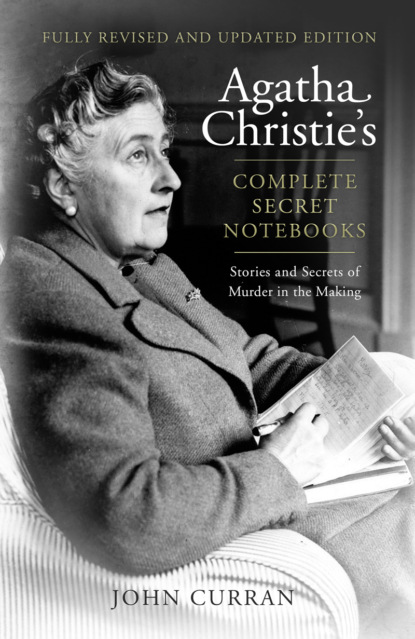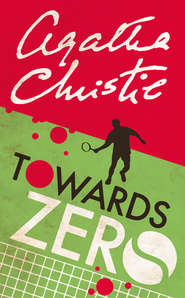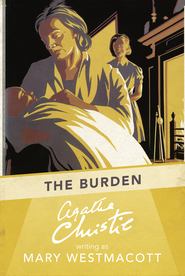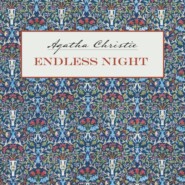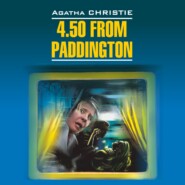По всем вопросам обращайтесь на: info@litportal.ru
(©) 2003-2024.
✖
Agatha Christie’s Complete Secret Notebooks
Настройки чтения
Размер шрифта
Высота строк
Поля
Apart from brief – and not totally convincing – forays into organised crime in The Big Four, The Secret of Chimneys and At Bertram’s Hotel, no use is made of a professional criminal in Christie’s solutions.
Van Dine 12. There must be but one culprit no matter how many murders are committed.
Murderous alliances are a feature of Christie’s fiction beginning with The Mysterious Affair at Styles and continuing with The Murder at the Vicarage, Death on the Nile, One, Two, Buckle my Shoe, Evil under the Sun, The Body in the Library, Sparkling Cyanide and Endless Night. Cat among the Pigeons and, to a lesser degree, Taken at the Flood, feature more than one killer working independently of each other; The Hollow features an unusual and morally questionable, collusion; and, of course, Murder on the Orient Express features the ultimate conspiracy.
The murder method
Christie never resorted to elaborate mechanical or scientific means to explain her ingenuity, and much of her popularity and accessibility lies in her adherence to this simplicity. Many of her last-chapter surprises can be explained in a few sentences. Once you have grasped the essential fact that the corpse identified as A is, in fact, Corpse B and vice versa everything else falls into place; when you realise that all twelve suspects conspired to murder one victim all confusion disappears; when it dawns that the name Evelyn can mean a male or a female little further explanation is necessary.
Van Dine 14. The method of murder, and the means of detecting it, must be rational and scientific.
Knox 4. No hitherto undiscovered poisons may be used, nor any appliance which will need long scientific explanation at the end.
While Christie uses poisons as a means of killing characters more than most of her contemporaries, she uses only those that are scientifically known. But, that said, thanks to her training as a dispenser, she had more knowledge of the subject than many of her fellow writers and was familiar with unusual poisons and the more unusual properties of the common ones. Her first novel, The Mysterious Affair at Styles, depends for its surprise solution on knowledge of the properties of strychnine, but this is not unreasonable as the reader is fully aware of the poison used. In fact, there is a graphic description of the death of Mrs Inglethorpe and a discussion of the effects of, and the chemical formula for, strychnine. Taxine in A Pocket Full of Rye, ricin in ‘The House of Lurking Death’ from Partners in Crime, thallium in The Pale Horse and physostigmine in Crooked House are just some of the unusual poisons featuring in Christie. Fictitious drugs such as Serenite in A Caribbean Mystery, Calmo in The Mirror Crack’d from Side to Side and Benvo in Passenger to Frankfurt also feature, but as the plot does not turn on their usage, they merely bend, rather than break, Knox’s Rule.
To be avoided
Some of these items are mere personal prejudice; there is no good reason why cigarettes or twins, for instance, cannot be a clue, or even a main plot device, provided that the reader has been properly prepared for them. With all of these the important point is the originality of the approach in utilising them – and this Christie had in full measure and overflowing.
Van Dine 13. Secret societies have no place in a detective story.
Many readers, including probably the author herself, would wish that The Big Four had never found its way between hard covers. Cobbled together at the lowest point in her life (after the death of her mother, the request for a divorce from her husband and her subsequent disappearance) with the help of her brother-in-law, Campbell Christie, this collection of linked short stories was re-edited into a novel. The ‘secret society’ bent on world domination that it features was, mercifully, a one-off aberration on Christie’s part. The Seven Dials Mystery features an equally preposterous secret society, albeit one with a Christie twist. The Pale Horse, one of the best books of the 1960s, features a mysterious organisation, Murder Inc., that seems to specialise in remote killing, but a rational and horribly plausible scheme is revealed in the closing chapters.
Knox 5. No Chinamen must figure in the story.
This comment is not as racist as it may first appear. At the time of its writing Orientals in fiction were perceived, under the general heading of ‘The Yellow Peril’, as the personification of everything undesirable. A more detailed discussion of the subject can be found in Colin Watson’s Snobbery with Violence (1971), an investigation of the social attitudes reflected in British crime fiction of the twentieth century, but suffice it to say that the white-slave trade, torture and other ‘unspeakable acts’ were the accepted fictional norms at the time for any character of Oriental extraction. This Rule was included to raise the literary horizon above that of the average opium den. Unfortunately, Christie succumbs to stereotype in The Big Four where, amid cringe-inducing scenes with Oriental characters and ‘speech’, the chief villain, ‘the greatest criminal brain of all time’, is Chinese. But these stories pre-dated Knox. Apart from The Big Four, and the more politically correct Poirot case ‘The Lost Mine’, no ‘Chinamen’ play a part in any of Christie’s detective novels.
Knox 3. Not more than one secret room or passage is allowable.
This Rule is taken to mean that no solution may turn on the existence of a secret passage. It was designed to eliminate the possibility of an exasperated reader hurling his detective novel across the room as the detective explains how the killer gained access to his closely guarded victim through such a passage, the existence of which was unknown up to that point. Christie is not above introducing the odd secret passage almost as a challenge to the cliché, but their very introduction long before the solution is in keeping with the tenet of this Rule. The Secret of Chimneys, Three Act Tragedy and ‘The Adventure of Johnnie Waverly’ all feature, but openly and not covertly, a secret room or passage. The play Spider’s Web features a sliding panel with a concealed cavity; and its use pokes gentle fun at this convention.
Knox 10. Twin brothers, and doubles generally, must not appear unless we have been duly prepared for them.
This Rule was formalised in an effort to avoid the disclosure that Suspect A, who had a cast-iron alibi for the night of the crime, was the guilty party because said alibi was provided by a hitherto unheard-of twin brother. Tongue firmly planted in literary cheek, Christie cocks a snook at this convention in ‘The Unbreakable Alibi’ in Partners in Crime. This is her take on the alibi-breaking stories of her contemporary Freeman Wills Crofts. And look at the ingenious double-bluff of Lord Edgware Dies. The Big Four also has an episode featuring a twin – one Achille Poirot …
Van Dine 20. A list of devices, which no self-respecting detective story writer should avail himself of …
The bogus séance to force a confession
At the end of Peril at End House Poirot arranges something very like a séance in End House, but it is really a variation on his usual ‘all-the-suspects-in-the-drawing-room’ ploy – although he does manage to elicit a confession. At the other end of a story is the séance in The Sittaford Mystery, where such an event is cleverly stage-managed in order to set a plot in motion.
The unmasking of a twin or look-alike
In Partners in Crime, Tommy and Tuppence tweak this Rule in ‘The Unbreakable Alibi’.
The cipher/code-letter
‘The Four Suspects’, in The Thirteen Problems, features a very clever version of the code-letter and in the last book she wrote, Postern of Fate, Tommy and Tuppence find a hidden message that launches their final case.
The comparison of cigarette butts
‘Murder in the Mews’ features not just this idea but also the clue of the cigarette smoke, or, more accurately, the absence of cigarette smoke.
Knox 2. All supernatural agencies are ruled out as a matter of course.
Van Dine 8. The problem of the crime must be solved by strictly naturalistic means.
These two Rules are, in effect, the same and are more strictly adhered to, but Christie experiments on various occasions, especially in her short story output. The virtually unknown radio play Personal Call has a supernatural twist at the last minute just when the listener thinks that everything has been satisfactorily, and rationally, explained. Dumb Witness features the Tripp sisters, quasi-spiritualists, but apart from her collection The Hound of Death, which has a supernatural rather than a detective theme, most of Chritie’s stories are firmly rooted in the natural, albeit sometimes evil, real world. The Pale Horse makes much of black magic and murder-by-suggestion but, like ‘The Voice in the Dark’ from The Mysterious Mr Quin and its seeming ghostly presence, all is explained away in rational terms.
Van Dine 3. There must be no love interest.
Although Van Dine managed this in his own books (thereby reducing them to semi-animated Cluedo), this Rule has been ignored by most successful practitioners. It is in the highest degree unlikely that, in the course of a 250-page novel, the ‘love interest’ can be completely excised while retaining some semblance of verisimilitude. Admittedly, Van Dine may have been thinking of some of the excesses of the Romantic suspense school, when matters of the heart take precedence over matters of the intellect; or when the reader can safely spot the culprit by pairing off the suspects until only one remains. Christie, as usual, turned this rule to her advantage. In some novels we confidently expect certain characters to walk up the aisle, instead of which one or more walk to the scaffold. In Death in the Clouds, Jane Grey gets as big a shock as the reader when the charming Norman Gale is unmasked as a cold-blooded murderer, in Taken at the Flood, Lynn is left pining after the ruthless David Hunter, and in They Came to Baghdad, Victoria is left to seek a replacement for the shy Edward. In some Christie novels the ‘love interest’ or, more accurately, the emotional element and personal interplay between the characters, is not just present but of a much higher standard than usual. In Five Little Pigs, The Hollow and Nemesis it is the emotional entanglements that set the plot in motion and provide the motivation; in each case it is thwarted love that motivates the killer.
Van Dine 16. A detective novel should contain no long descriptive passages, no literary dallying with side-issues, no subtly worked-out character analyses, and no ‘atmospheric’ preoccupations.
This Rule merely mirrors the time in which it was written: and it would be no bad thing to reintroduce it to some present-day practitioners. That said, character analysis and atmosphere can play an important part in a solution. In The Moving Finger, it is only when Miss Marple looks beyond the ‘atmosphere’ of fear in Lymstock that the solutions to both the poison-pen letters and the identity of the murderer become clear. In Cards on the Table the only physical clues are the bridge scorecards and Poirot has to depend largely on the character of the bridge-players, as shown by these scorecards, to arrive at the truth. In Five Little Pigs, an investigation into the murder committed sixteen years earlier has to rely almost solely on the evidence and accounts of the suspects, a procedure largely dependent on character analysis. In The Hollow, it is from his study of the characters staying for the weekend at The Hollow that Poirot uncovers the truth of the crime.
RULE OF THREE: SUMMARY
The Knox Decalogue is by far the more reasonable of the two sets of Rules. Written somewhat tongue-in-cheek – ‘Not more than one secret room or passage is allowable’ – it is less repetitive and restrictive and shows less personal prejudice than does its American counterpart. A strict adherence to Van Dine’s Rules would have resulted in an arid, uninspired and ultimately predictable genre. It would have meant forgoing (much of) the daring brilliance of Christie, the inventive logic of Ellery Queen, the audacious ingenuity of John Dickson Carr or the formidable intelligence of Dorothy L. Sayers. In later years it would have precluded the witty cunning of Edmund Crispin, the erudite originality of Michael Innes or the boundary-pushing output of Julian Symons. Van Dine’s list is repetitive and, in many instances, a reflection of his personal bias: no long descriptive passages, no literary dallying with side-issues, no subtly worked-out character analyses, no ‘atmospheric’ preoccupations. It is somewhat ironic that while the compilers of both lists are largely forgotten nowadays, the writer who managed to break most of their carefully considered Rules remains the best-selling and most popular writer in history.
And so, from The Mysterious Affair at Styles in 1920 until Sleeping Murder in 1976, Agatha – Rule-Keeper and Rule-Breaker – produced at least one book a year and for nearly twenty of those years she produced two titles. The slogan ‘A Christie for Christmas’ was a fixture in Collins’s publishing list and in 1935 it became clear that the name of Agatha Christie was to be a perennial best seller. That year, Three Act Tragedy sold 10,000 hardback copies and this figure trebled over the next decade. By the time of her fiftieth title, A Murder is Announced, she matched it with sales of 50,000; and never looked back. And all of this without the media circus that is now part and parcel of the book trade – no radio or TV interviews, no signing sessions, no question-and-answer panels and virtually no public appearances.
Although mutually advantageous, the relationship between Christie and her publisher was by no means free of controversy. The proposed jacket design for The Labours of Hercules horrified her (‘Poirot going naked to the bath’), she considered that an announcement in ‘Crime Club News’ about 1939’s Ten Little Niggers – its title later amended to the more acceptable And Then There Were None – revealed too much of the plot and in September 1967 she sent Sir William (‘Billy’) Collins a blistering letter for having received her so-called ‘advance copies’ of Endless Night only after she saw them herself on sale at the airport. And as late as 1968 she wrote her own blurb for By the Pricking of my Thumbs.
Thanks to her phenomenal sales and prodigious output, she became a personal friend of Sir William and his wife, Pierre, and conducted much of her correspondence through the years directly with him. They were regular visitors to Greenway, her Devon retreat, and Sir William was one of those who spoke at her memorial service in May 1976. A measure of the respect in which he held her can be gauged from his closing remarks, when he said that ‘the world is better because she lived in it’.
5 (#ulink_41f4c1c3-618f-56e2-90ba-60fe1a3f033e)
Crime Writers in the Notebooks (#ulink_41f4c1c3-618f-56e2-90ba-60fe1a3f033e)
‘Do you like detective stories? I do. I read them all and I’ve got autographs from Dorothy Sayers and Agatha Christie and Dickson Carr and H. C. Bailey.’
The Body in the Library, Chapter 6
Dotted through Christie’s Notebooks are references to other crime novels and their writers. Many of these are fellow-writers, and their work known to her through her membership of the Detection Club. Proof that she was widely-read in her chosen genre is evident from passing references to the work of other writers not personally known to her. And, finally and intriguingly, there are references to her own work.
The Detection Club in the Notebooks
The Detection Club, as its name suggests, is a club for writers of detective stories. Although the exact date is uncertain, it was probably founded in 1929. Anthony Berkeley and Dorothy L. Sayers were two of the founders and by the early 1930s all of the major writers of detective fiction of the day, including Agatha Christie, were members. Only writers of detective fiction, as distinct from crime writers in general, were eligible to join. It was not a professional body campaigning to improve the lot of crime writers; rather it was a glorified dining club with G.K. Chesterton, creator of Father Brown, as its first President, followed in 1936 by E.C. Bentley, author of the famous Trent’s Last Case, and, from 1958 to her death in 1976, Agatha Christie. She agreed to this role on the understanding that she would never have to make a speech. Membership was by invitation only and all new members had to undergo an initiation ceremony, involving the President in ceremonial robes, a procession with candles and the initiate swearing an oath, while placing a hand on Eric the Skull, to uphold the club’s rules.
Although these rules were unwritten and the ritual itself, designed by Sayers, light-hearted, the intentions behind them were serious and admirable. In an effort to raise the literary level of the detective story and to distinguish it from the thriller or ‘shocker’, candidates had to promise:
to honour the King’s English;
never to conceal a vital clue from the reader;
to adhere to detection as distinct from ‘Divine Revelation, Feminine Intuition … Coincidence or Acts of God’;





